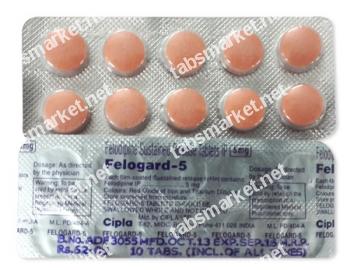Common use
Plendil is a Ca+ channel blocker and prevents calcium from being released within the muscle cells of the small arteries so muscles relax and the arteries dilate or expand. Plendil does not affect tone of veins. Plendil is used to treat arterial hypertension, angina, Raynaud's phenomenon.
Dosage and direction
The medication should be taken once daily without food or with a small meal as food influences its absorption. Do not chew, crush or break the tab, it should be taken whole.
Missed dose
Never take a double dose of this medication. If it is almost time of the next dose just skip the missed portion and continue to take the medicine according to the schedule.
Overdose
Symptoms of a overdose are chest pain, dizziness, weakness, and confusion, shortness of breath, fainting, unusually fast or slow heartbeat, coma, slurred speech. If you experience this call your doctor immediately.
Storage
Tablets and capsules should be stored at room temperature between 15-30 C (59-86 F) away from light and moisture.
Precautions
Grapefruit or grape juice may increases its absorption and may lead to sudden drops in blood pressure. Brush and floss your teeth regularly according prescriptions of your doctor. Plendil is known to cause swelling of the gums as one of side effects. Proper oral hygiene will alleviate this.
Contraindications
Hypersensitivity, severe arterial hypotension, pregnancy, breastfeeding. Caution should be exercised in patients with sick sinus syndrome, decompensated chronic heart failure, light or moderate arterial hypotension, arterial stenosis, acute myocardial infraction, in aged patients and children younger than 18 y.o. and some other cases.
Drug interaction
Plendil increases level of digoxin in blood so it may cause changes in vision. Cimetidine is able to influence metabolism of Plendil so concentration of the last may increase resulting in drops in blood pressure. Plendil levels in blood are decreased by Carbamazepine, phenobarbital, or phenytoin.
Disclaimer
We provide only general information about medications which does not cover all directions, possible drug integrations, or precautions. Information at the site cannot be used for self-treatment and self-diagnosis. Any specific instructions for a particular patient should be agreed with your health care adviser or doctor in charge of the case. We disclaim reliability of this information and mistakes it could contain. We are not responsible for any direct, indirect, special or other indirect damage as a result of any use of the information on this site and also for consequences of self-treatment.
Possible side effect
Most common side effects are swollen ankles and feet, headache, dizziness, unusually fast or slow heartbeat, an allergic reaction, jaundice. If you experience these side effects contact your doctor and seek for immediate medical attention.




 Delivery
Delivery Delivery
Delivery
























